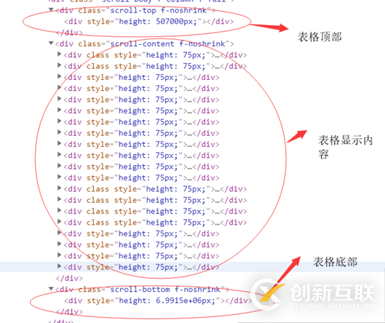如何使用vue解決web端超大數(shù)據(jù)量表格的卡頓問題-創(chuàng)新互聯(lián)
這篇文章將為大家詳細(xì)講解有關(guān)如何使用vue解決web端超大數(shù)據(jù)量表格的卡頓問題,小編覺得挺實(shí)用的,因此分享給大家做個(gè)參考,希望大家閱讀完這篇文章后可以有所收獲。

一、整體思路
1.思路來源
公司有一個(gè)定位系統(tǒng),基本上來說一個(gè)定位單位一分鐘或者更短就會(huì)有一個(gè)定位點(diǎn),這樣一天下來就會(huì)有很多定位點(diǎn)了,如果表格想要一下子放一天甚至三天的數(shù)據(jù),那么數(shù)據(jù)量將會(huì)特別大(可能會(huì)到達(dá)5萬條左右的數(shù)據(jù)),如果我們顯示的列又比較多的話,那么表格的卡頓問題就會(huì)很明顯了。我們公司web端選擇的ui框架是 iview ,說實(shí)話 iview 的其他組件還行,不過表格的話在大量數(shù)據(jù)面前顯得很疲軟,反而我以前使用的 easyui 之類的老框架的表格性能和功能上都很好,畢竟它們已經(jīng)經(jīng)歷了很多優(yōu)化,表格這個(gè)組件的拓展性很大,想要在性能和功能上都做好十分的困難。
easyui 是個(gè)與時(shí)俱進(jìn)的框架,有一次我點(diǎn)開它的官網(wǎng)發(fā)現(xiàn)它已經(jīng)出了基于現(xiàn)在熱門的 vue、react、angular 的ui組件。于是我這次選擇去看看它基于vue的表格,于是我看到了這個(gè)組件附上連接http://www.jeasyui.net/demo_vue/681.html 。我發(fā)現(xiàn)它通過分頁延遲加載的方法解決了大數(shù)據(jù)量卡斷的問題,這是我基本能夠理解的,不過看完之后我有一些疑問,首先如果他只渲染了一部分?jǐn)?shù)據(jù),在滾動(dòng)條滾動(dòng)的時(shí)候再加載數(shù)據(jù),那么為什么滾動(dòng)條為什么一直是那么長。機(jī)智的我打開了開發(fā)者模式查看了表格部分的html代碼

一看我明白了,圖中的表格底部和表格頂部部分就是滾動(dòng)條高度一直不變的原因,而中間部分更具滾動(dòng)條的滾動(dòng)始終只加載40條數(shù)據(jù),這樣大數(shù)據(jù)量的表格卡頓問題就解決了
2.思路確認(rèn)
那么思路我們基本上可以有了,我們來理一下。
首先我們可以認(rèn)為這個(gè)表格分為 3個(gè)部分 [表格頂部:( top )、表格滾動(dòng)區(qū)域:( screen )、表格底部:( bottom )]。
top 和 bottom 部分的問題是高度的計(jì)算,基本上可以確定應(yīng)該再滾動(dòng)條滾動(dòng)的時(shí)候,得到滾動(dòng)的位置,然后更具總數(shù)據(jù)量和 screen 部分的數(shù)據(jù)量計(jì)算出 top 和 bottom 的高度,想到這里我腦海里就出現(xiàn)了幾個(gè)字( 計(jì)算屬性 )用在這里應(yīng)該再合適不過了。
screen 部分的實(shí)現(xiàn)心中的初步想法是更具滾動(dòng)高度計(jì)算應(yīng)該加載的數(shù)據(jù)。不過如何做到在過度數(shù)據(jù)的時(shí)候更加流暢,心中還有一些些疑惑于是我繼續(xù)觀察了它的html。為了更好的表述,前端達(dá)芬奇打開了他的畫圖軟件開始了作畫(●'?'●)

首先我們剛剛提到了screen部分始終顯示40條數(shù)據(jù),所以我們通過滾動(dòng)事件判斷當(dāng)頁面滾動(dòng)到超過screenbottom部分的底部的時(shí)候我們就向下加載20條數(shù)據(jù)同時(shí)刪除screentop部分的數(shù)據(jù)這樣用戶使用的時(shí)候不會(huì)出現(xiàn)向下滾動(dòng)加載然后輕微上移又要加載的情況。看到這里很多人肯定在想如果這個(gè)用戶是個(gè)皮皮怪,拉著滾動(dòng)條瘋狂拖動(dòng)怎么辦,那我們就再來看一張圖片(●'?'●)

如果皮皮怪們將滾動(dòng)條滾到了大于本來待加載20條數(shù)據(jù)高度的位置,我們就用新的處理方式刪除所有的40條數(shù)據(jù),根據(jù)滾動(dòng)的位置計(jì)算當(dāng)前位置上下各20條的數(shù)據(jù)。再這個(gè)過程當(dāng)中可能會(huì)出現(xiàn)表格變白一下的過程,不過我覺得應(yīng)該可以通過遮罩層來處理。
基本上的思路有了,那么我們開始實(shí)現(xiàn)它吧 (●'?'●)。
二、實(shí)現(xiàn)過程
(首先我先說一下,我實(shí)現(xiàn)的這個(gè)表格并不是考慮的那么全面,開發(fā)的初衷只是解決卡斷這個(gè)問題,表格排序多選之類的功能等之后再拓展)
1.表格的結(jié)構(gòu)
表格通過2個(gè)table標(biāo)簽組成,第一個(gè)是表頭第二個(gè)是數(shù)據(jù)內(nèi)容,方便后期拓展。這里偷懶沒有把表頭和內(nèi)部內(nèi)容和tr再單獨(dú)成一個(gè)組件讓代碼可讀性更好之后還可以再優(yōu)化。
2.邏輯實(shí)現(xiàn)
我們直接說最主要的邏輯部分,首先我們看看props和data部分
props: {
loadNum: {
//默認(rèn)加載行數(shù)
type: [Number, String],
default() {
return 20;
}
},
tdHeight: {
//表格行高
type: [Number, String],
default() {
return 40;
}
},
tableHeight: {
//表格高度
type: [Number, String],
default() {
return "200";
}
},
tableList: {
//所有表格數(shù)據(jù)
type: Array,
default() {
return [];
}
},
columns: {
//所有表格匹配規(guī)則
type: Array,
default() {
return [];
}
},
showHeader: {
type: Boolean,
default: true
}
},
data() {
return {
isScroll: 17,
showLoad: false,
columnsBottom: [], //實(shí)際渲染表格規(guī)則
showTableList: [], //實(shí)際顯示的表格數(shù)據(jù)
loadedNum: 0, //實(shí)際渲染的數(shù)據(jù)數(shù)量
dataTotal: 0, //總數(shù)據(jù)條數(shù)
dataTop: 0, //渲染數(shù)據(jù)頂部的高度
scrollTop: 0, //滾動(dòng)上下的距離
interval: null, //判斷滾動(dòng)是否停止的定時(shí)器
scrollHeight: 0, //數(shù)據(jù)滾動(dòng)的高度
selectTr: -1 //選擇的行
};
},然后我們看看滾動(dòng)事件應(yīng)該做一些什么先上代碼
//滾動(dòng)條滾動(dòng)
handleScroll(event) {
let bottomScroll = document.getElementById("bottomDiv");
let topScroll = document.getElementById("topDiv");
if (bottomScroll.scrollTop > this.scrollTop) {
//記錄上一次向下滾動(dòng)的位置 this.scrollTop = bottomScroll.scrollTop; //向下滾動(dòng)
this.handleScrollBottom();
} else if (bottomScroll.scrollTop < this.scrollTop) {
//記錄上一次向上滾動(dòng)的位置
this.scrollTop = bottomScroll.scrollTop;
//向上滾動(dòng)
this.handleScrollTop();
} else {
//左右滾動(dòng)
this.handleScrollLeft(topScroll, bottomScroll);
}
}首先我們通過 scrollTop 這個(gè)變量在每次進(jìn)入滾動(dòng)事件的時(shí)候記錄垂直滾動(dòng)條的位置,如果這個(gè)值 不變 那么這次滾動(dòng)就是 左右滾動(dòng), 如果這個(gè)值 變大 看那么就是 向下滾動(dòng) ,如果這個(gè)值 變小 了那么就是 向上滾動(dòng) 。左右滾動(dòng)的時(shí)候我們需要做的事情就是讓表頭隨著內(nèi)容一起移動(dòng),這樣就可以達(dá)到左右移動(dòng)表頭動(dòng)上下移動(dòng)表頭固定的效果。
//滾動(dòng)條左右滾動(dòng)
handleScrollLeft(topScroll, bottomScroll) {
//頂部表頭跟隨底部滾動(dòng)
topScroll.scrollTo(bottomScroll.scrollLeft, topScroll.pageYOffset);
},如果是向上移動(dòng)我們就要做我們在思路中提高的事情了先看代碼
//滾動(dòng)條向上滾動(dòng)
handleScrollTop() {
//如果加載的數(shù)據(jù)小于默認(rèn)加載的數(shù)據(jù)量
if (this.dataTotal > this.loadNum) {
let computeHeight = this.dataTop; //數(shù)據(jù)需要處理的時(shí)候的高度
if (
this.scrollTop < computeHeight &&
this.scrollTop >= computeHeight - this.loadNum * this.tdHeight
) {
this.showLoad = true;
//如果滾動(dòng)高度到達(dá)數(shù)據(jù)顯示頂部高度
if (this.dataTotal > this.loadedNum) {
//如果數(shù)據(jù)總數(shù)大于已經(jīng)渲染的數(shù)據(jù)
if (this.dataTotal - this.loadedNum >= this.loadNum) {
//如果數(shù)據(jù)總數(shù)減去已經(jīng)渲染的數(shù)據(jù)大于等于loadNum
this.dataProcessing(
this.loadNum,
this.loadedNum - this.loadNum,
"top"
);
} else {
this.dataProcessing(
this.dataTotal - this.loadedNum,
this.dataTotal - this.loadedNum,
"top"
);
}
}
} else if (
this.scrollTop <
computeHeight - this.loadNum * this.tdHeight
) {
this.showLoad = true;
let scrollNum = parseInt(this.scrollTop / this.tdHeight); //滾動(dòng)的位置在第幾條數(shù)據(jù)
if (scrollNum - this.loadNum >= 0) {
this.dataProcessing(this.loadNum * 2, scrollNum, "topAll");
} else {
this.dataProcessing(scrollNum + this.loadNum, scrollNum, "topAll");
}
}
}
},首先我們判斷加載的數(shù)據(jù)是否小于默認(rèn)加載的數(shù)據(jù)量,如果時(shí)那么就不需要做任何邏輯了,因?yàn)橐呀?jīng)加載了所有的數(shù)據(jù)了。
判斷滾動(dòng)高度是不是已經(jīng)超過了當(dāng)前screen部分?jǐn)?shù)據(jù)的頂部位置并且小于當(dāng)前screen部分?jǐn)?shù)據(jù)的頂部位置減去默認(rèn)加載數(shù)據(jù)量的高度,也就是我們之前提到第一種情況,那么大于當(dāng)前screen部分?jǐn)?shù)據(jù)的頂部位置減去默認(rèn)加載數(shù)據(jù)量的高度就是第二種情況了。
如果進(jìn)入2個(gè)判斷this.showLoad設(shè)置為true,將遮罩層打開,避免表格變白影響用戶的體驗(yàn),提示在加載。
第一種情況如果數(shù)據(jù)頂部小于默認(rèn)加載數(shù)據(jù),我們只加載剩余高度的數(shù)據(jù)如果大于則加載默認(rèn)加載的this.loadNum數(shù)量的數(shù)據(jù)
第二種情況也是一樣判斷只不過判斷this.loadNum*2是否大于數(shù)據(jù)頂部的數(shù)據(jù)條數(shù),只加載剩余高度的數(shù)據(jù)或者加載this.loadNum*2數(shù)量的數(shù)據(jù)。
向下滾動(dòng)其實(shí)是一樣的思路我們看一下代碼
//滾動(dòng)條向下滾動(dòng)
handleScrollBottom() {
let computeHeight =
this.dataTop +
this.loadedNum * this.tdHeight -
(this.tableHeight - this.tdHeight - 3); //數(shù)據(jù)需要處理的時(shí)候的高度
if (
this.scrollTop > computeHeight &&
this.scrollTop <= computeHeight + this.tdHeight * this.loadNum
) {
this.showLoad = true;
//如果滾動(dòng)高度到達(dá)數(shù)據(jù)顯示底部高度
if (this.dataTotal > this.loadedNum) {
//如果數(shù)據(jù)總數(shù)大于已經(jīng)渲染的數(shù)據(jù)
if (this.dataTotal - this.loadedNum >= this.loadNum) {
//如果數(shù)據(jù)總數(shù)減去已經(jīng)渲染的數(shù)據(jù)大于等于20
this.dataProcessing(
this.loadedNum - this.loadNum,
this.loadNum,
"bottom"
);
} else {
this.dataProcessing(
this.dataTotal - this.loadedNum,
this.dataTotal - this.loadedNum,
"bottom"
);
}
}
} else if (
this.scrollTop >
computeHeight + this.tdHeight * this.loadNum
) {
this.showLoad = true;
let scrollNum = parseInt(this.scrollTop / this.tdHeight); //滾動(dòng)的位置在第幾條數(shù)據(jù)
if (scrollNum + this.loadNum <= this.dataTotal) {
this.dataProcessing(scrollNum, this.loadNum * 2, "bottomAll");
} else {
this.dataProcessing(
scrollNum,
this.dataTotal - scrollNum + this.loadNum,
"bottomAll"
);
}
}
},計(jì)算了好了有4種情況,并且計(jì)算出了對(duì)應(yīng)需要?jiǎng)h除和新增的數(shù)據(jù)量。我們來看看dataProcessing這個(gè)函數(shù)做了什么事情。
//上下滾動(dòng)時(shí)數(shù)據(jù)處理
dataProcessing(topNum, bottomNum, type) {
let topPosition = parseInt(this.dataTop / this.tdHeight);
if (type === "top") {
this.showTableList.splice(this.loadedNum - bottomNum, bottomNum); //減去底部數(shù)據(jù)
for (var i = 1; i <= topNum; i++) {
//加上頂部數(shù)據(jù)
let indexNum = topPosition - i;
this.tableList[indexNum].index = indexNum + 1;
this.showTableList.unshift(this.tableList[indexNum]);
}
this.loadedNum = this.loadedNum + topNum - bottomNum; //重新計(jì)算實(shí)際渲染數(shù)據(jù)條數(shù)
this.dataTop = this.dataTop - topNum * this.tdHeight; //重新計(jì)算渲染數(shù)據(jù)的高度
document.getElementById("bottomDiv").scrollTop =
document.getElementById("bottomDiv").scrollTop +
bottomNum * this.tdHeight;
this.scrollTop = document.getElementById("bottomDiv").scrollTop;
} else if (type == "bottom") {
this.showTableList.splice(0, topNum); //減去頂部數(shù)據(jù)
for (var i = 0; i < bottomNum; i++) {
//加上底部數(shù)據(jù)
let indexNum = topPosition + this.loadedNum + i;
this.tableList[indexNum].index = indexNum + 1;
this.showTableList.push(this.tableList[indexNum]);
}
this.loadedNum = this.loadedNum - topNum + bottomNum; //重新計(jì)算實(shí)際渲染數(shù)據(jù)條數(shù)
this.dataTop = this.dataTop + topNum * this.tdHeight; //重新計(jì)算渲染數(shù)據(jù)的高度
document.getElementById("bottomDiv").scrollTop =
document.getElementById("bottomDiv").scrollTop -
topNum * this.tdHeight;
this.scrollTop = document.getElementById("bottomDiv").scrollTop;
} else if (type == "bottomAll") {
this.showTableList = []; //減去頂部數(shù)據(jù)
let scrollNum = topNum;
for (var i = 0; i < bottomNum; i++) {
//加上底部數(shù)據(jù)
let indexNum = scrollNum - this.loadNum + i;
this.tableList[indexNum].index = indexNum + 1;
this.showTableList.push(this.tableList[indexNum]);
}
this.loadedNum = bottomNum; //重新計(jì)算實(shí)際渲染數(shù)據(jù)條數(shù)
this.dataTop = (scrollNum - this.loadNum) * this.tdHeight; //重新計(jì)算渲染數(shù)據(jù)的高度
this.scrollTop = document.getElementById("bottomDiv").scrollTop;
} else if (type == "topAll") {
this.showTableList = []; //減去頂部數(shù)據(jù)
let scrollNum = bottomNum;
for (var i = 0; i < topNum; i++) {
//加上底部數(shù)據(jù)
let indexNum = scrollNum - topNum + this.loadNum + i;
this.tableList[indexNum].index = indexNum + 1;
this.showTableList.push(this.tableList[indexNum]);
}
this.loadedNum = topNum; //重新計(jì)算實(shí)際渲染數(shù)據(jù)條數(shù)
this.dataTop = (scrollNum - topNum + this.loadNum) * this.tdHeight; //重新計(jì)算渲染數(shù)據(jù)的高度
this.scrollTop = document.getElementById("bottomDiv").scrollTop;
}
this.showLoad = false;
},首先先刪除我們之前計(jì)算好的應(yīng)該刪除的數(shù)據(jù)我們用 splice 方法刪除對(duì)應(yīng)的數(shù)據(jù),然后通過一個(gè)簡單的for循環(huán),如果是向上滾動(dòng)應(yīng)該將數(shù)據(jù)加在頂部我們用 unshift 方法,如果是向下滾動(dòng)我們應(yīng)該加在底部我們用 push 方法。
處理好數(shù)據(jù)以后我們還需要重新計(jì)算實(shí)際渲染數(shù)據(jù)條數(shù),將loadedNum的值改為現(xiàn)在顯示的數(shù)據(jù)條數(shù)
重新計(jì)算渲染數(shù)據(jù)的高度,計(jì)算出dataTop現(xiàn)在顯示的數(shù)據(jù)頂部的高度
因?yàn)?top 和 bottom 的變化會(huì)導(dǎo)致表格scrollTop的值出現(xiàn)變化,這個(gè)時(shí)候我們就要?jiǎng)討B(tài)把滾動(dòng)條移動(dòng)到正確的位置
最后我們來說說之前考慮的 top 和 bottom ,一開始我們就想好了應(yīng)該用計(jì)算屬性去做,事實(shí)也說明的確這樣,我們看看代碼
computed: {
tableOtherTop() {
//表格剩余數(shù)據(jù)頂部高度
return this.dataTop;
},
tableOtherBottom() {
//表格剩余數(shù)據(jù)底部高度
return (
this.dataTotal * this.tdHeight -
this.dataTop -
this.loadedNum * this.tdHeight
);
}
},這樣就能保證 top 和 bottom 高度的變化能夠觸發(fā)表格的變化。
top 的高度應(yīng)該就是顯示數(shù)據(jù)頂部的高度( dataTop )。
bottom 的高度應(yīng)該就是數(shù)據(jù)的總高度-顯示的數(shù)據(jù)的高度( this.loadedNum * this.tdHeight )- top 的高度。
最后我們來看看效果圖

關(guān)于“如何使用vue解決web端超大數(shù)據(jù)量表格的卡頓問題”這篇文章就分享到這里了,希望以上內(nèi)容可以對(duì)大家有一定的幫助,使各位可以學(xué)到更多知識(shí),如果覺得文章不錯(cuò),請(qǐng)把它分享出去讓更多的人看到。
另外有需要云服務(wù)器可以了解下創(chuàng)新互聯(lián)scvps.cn,海內(nèi)外云服務(wù)器15元起步,三天無理由+7*72小時(shí)售后在線,公司持有idc許可證,提供“云服務(wù)器、裸金屬服務(wù)器、高防服務(wù)器、香港服務(wù)器、美國服務(wù)器、虛擬主機(jī)、免備案服務(wù)器”等云主機(jī)租用服務(wù)以及企業(yè)上云的綜合解決方案,具有“安全穩(wěn)定、簡單易用、服務(wù)可用性高、性價(jià)比高”等特點(diǎn)與優(yōu)勢,專為企業(yè)上云打造定制,能夠滿足用戶豐富、多元化的應(yīng)用場景需求。
分享文章:如何使用vue解決web端超大數(shù)據(jù)量表格的卡頓問題-創(chuàng)新互聯(lián)
標(biāo)題來源:http://www.chinadenli.net/article10/dossgo.html
成都網(wǎng)站建設(shè)公司_創(chuàng)新互聯(lián),為您提供標(biāo)簽優(yōu)化、響應(yīng)式網(wǎng)站、網(wǎng)站收錄、網(wǎng)站制作、品牌網(wǎng)站設(shè)計(jì)、品牌網(wǎng)站制作
聲明:本網(wǎng)站發(fā)布的內(nèi)容(圖片、視頻和文字)以用戶投稿、用戶轉(zhuǎn)載內(nèi)容為主,如果涉及侵權(quán)請(qǐng)盡快告知,我們將會(huì)在第一時(shí)間刪除。文章觀點(diǎn)不代表本網(wǎng)站立場,如需處理請(qǐng)聯(lián)系客服。電話:028-86922220;郵箱:631063699@qq.com。內(nèi)容未經(jīng)允許不得轉(zhuǎn)載,或轉(zhuǎn)載時(shí)需注明來源: 創(chuàng)新互聯(lián)
猜你還喜歡下面的內(nèi)容
- 利用php怎么對(duì)執(zhí)行時(shí)間進(jìn)行計(jì)算-創(chuàng)新互聯(lián)
- 安卓打開文件瀏覽器,選擇文件后得到返回路徑-創(chuàng)新互聯(lián)
- VueJs中怎么實(shí)現(xiàn)父子組件通訊-創(chuàng)新互聯(lián)
- 數(shù)字零售,一個(gè)全新的存在-創(chuàng)新互聯(lián)
- 在django中實(shí)現(xiàn)分頁功能的方法-創(chuàng)新互聯(lián)
- 織夢去除img中stylewidthheight屬性的方法-創(chuàng)新互聯(lián)
- 如何實(shí)現(xiàn)php的$_FILES的臨時(shí)儲(chǔ)存文件與回收機(jī)制-創(chuàng)新互聯(lián)

- 用戶體驗(yàn)其實(shí)就這么簡單! 2022-06-07
- 深圳福田網(wǎng)站設(shè)計(jì)與制作,品牌網(wǎng)站設(shè)計(jì)制作的步驟是什么? 2021-11-20
- 企業(yè)品牌網(wǎng)站設(shè)計(jì)思路介紹 2023-01-29
- 品牌網(wǎng)站設(shè)計(jì)如何做好用戶體驗(yàn) 2021-10-03
- 網(wǎng)站制作專業(yè)公司更相符公司的成長請(qǐng)求 2022-06-04
- 怎樣做成都品牌網(wǎng)站設(shè)計(jì)才有效果? 2016-12-27
- 品牌網(wǎng)站設(shè)計(jì)中大小標(biāo)題之間的色彩關(guān)系 2022-12-03
- 品牌網(wǎng)站設(shè)計(jì)的頁腳樣式是什么 2021-06-20
- 如何做好網(wǎng)站設(shè)計(jì)?企業(yè)品牌網(wǎng)站設(shè)計(jì)重要指南 2022-08-16
- 常見的營銷網(wǎng)站類型你了解嗎 企業(yè)品牌網(wǎng)站設(shè)計(jì)思路 2021-05-11
- 4個(gè)消費(fèi)電子產(chǎn)品的品牌網(wǎng)站設(shè)計(jì) 2021-09-28
- 品牌網(wǎng)站設(shè)計(jì)要遵守哪些原則 2023-03-11